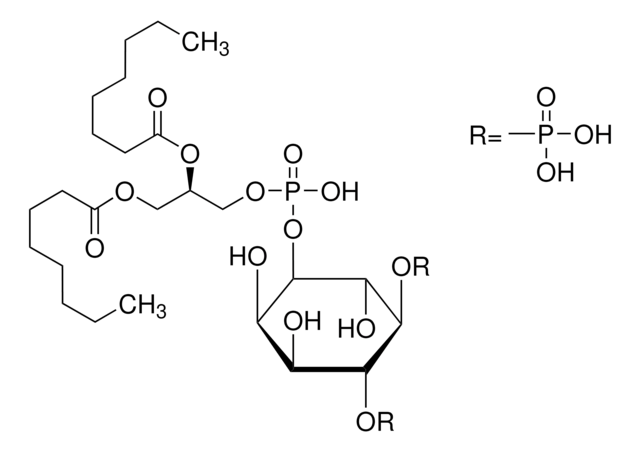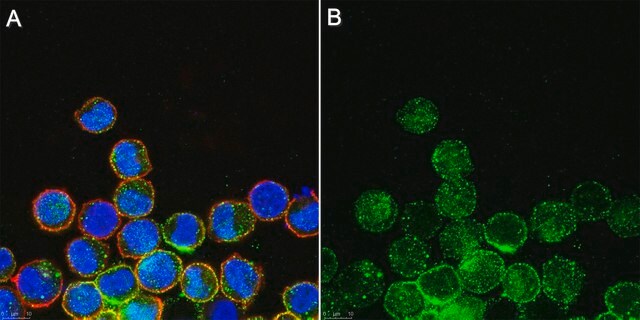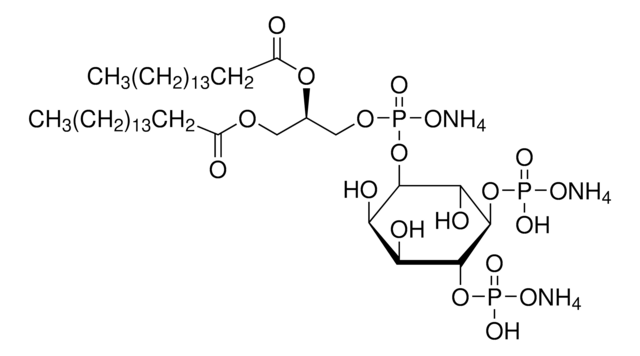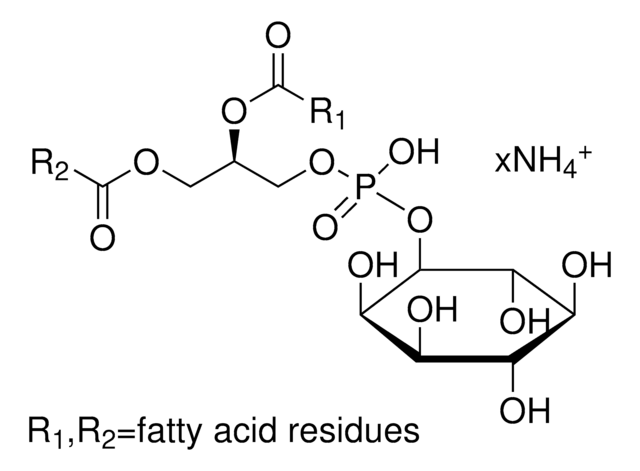524644
L-α-fosfatydylo-D-mio-inozytolo-4,5-bisfosforan, sól triammonowa, mózg świni
A component of membrane-bound receptors in association with phospholipase C (PLC).
Synonim(y):
PIP₂
About This Item
Polecane produkty
Poziom jakości
Próba
≥98% (TLC)
Formularz
solid
producent / nazwa handlowa
Calbiochem®
warunki przechowywania
OK to freeze
desiccated (hygroscopic)
protect from light
kolor
white to off-white
rozpuszczalność
water: 10 mg/mL
chloroform: 50 mg/mL
Warunki transportu
wet ice
temp. przechowywania
−70°C
ciąg SMILES
[P](=O)(O[C@@H]1C([C@@H](C(C(C1O)O[P](=O)(O)O)O[P](=O)(O)O)O)O)(OC[C@H](OC(=O)CCC\C=C/C\C=C/C\C=C/C\C=C/CCCCC)COC(=O)CCCCCCCCCCCCCCCCC)O.N.N.N
InChI
1S/C47H85O19P3.3H3N/c1-3-5-7-9-11-13-15-17-19-20-22-24-26-28-30-32-34-36-41(49)63-39(37-61-40(48)35-33-31-29-27-25-23-21-18-16-14-12-10-8-6-4-2)38-62-69(59,60)66-45-42(50)43(51)46(64-67(53,54)55)47(44(45)52)65-68(56,57)58;;;/h11,13,17,19,22,24,28,30,39,42-47,50-52H,3-10,12,14-16,18,20-21,23,25-27,29,31-38H2,1-2H3,(H,59,60)(H2,53,54,55)(H2,56,57,58);3*1H3/b13-11-,19-17-,24-22-,30-28-;;;/t39-,42?,43+,44?,45-,46?,47?;;;/m1.../s1
Klucz InChI
GAIOWTITBYPFJE-JVILRMJCSA-N
Opis ogólny
Uwaga: Ten produkt nie może być stosowany do leczenia zwierząt, badań in vivo ani w żadnej innej procedurze kontaktu ze zwierzętami gospodarskimi.
Działania biochem./fizjol.
Mózgowa fosfolipaza D (PLD)
Opakowanie
Ostrzeżenie
Rekonstytucja
Inne uwagi
Shyng, S.-L., and Nichols, C.G. 1998. Science 282, 1138.
Mazzotti, G., et al. 1995. J. Histochem. Cytochem. 43, 181.
Liscovitch, M., et al. 1994. J. Biol. Chem. 269, 21403.
Chauhan, A., et al. 1991. Biochem. Biophys. Res. Commun. 175, 852.
Williamson, J.R. 1986. Hypertension 8, 140.
Berridge, M.J., and Irvine, R.F. 1984. Nature 312, 315.
Informacje prawne
Kod klasy składowania
11 - Combustible Solids
Klasa zagrożenia wodnego (WGK)
WGK 3
Temperatura zapłonu (°F)
Not applicable
Temperatura zapłonu (°C)
Not applicable
Certyfikaty analizy (CoA)
Poszukaj Certyfikaty analizy (CoA), wpisując numer partii/serii produktów. Numery serii i partii można znaleźć na etykiecie produktu po słowach „seria” lub „partia”.
Masz już ten produkt?
Dokumenty związane z niedawno zakupionymi produktami zostały zamieszczone w Bibliotece dokumentów.
Nasz zespół naukowców ma doświadczenie we wszystkich obszarach badań, w tym w naukach przyrodniczych, materiałoznawstwie, syntezie chemicznej, chromatografii, analityce i wielu innych dziedzinach.
Skontaktuj się z zespołem ds. pomocy technicznej








